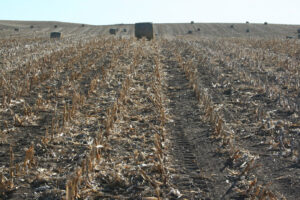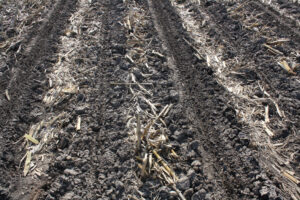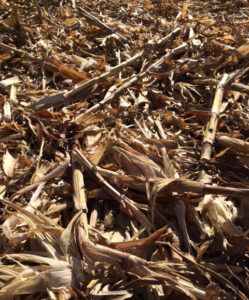Considerations for Residue Management
Crop residue retention improves the biological, physical, and chemical properties of soil. Additionally, nutrient recycling is a reason to conserve residue through no-till or minimal-tillage field management. Conservation tillage increases these benefits, though it also increases the inoculum sources for certain corn diseases. Crop residue has long been known as an inoculum source to spread disease.
Epidemics of soil-borne diseases tend to occur when susceptible crops are grown for several consecutive years. Crop residues and soil contain pathogens that can remain in their dormant state until conditions favor the development of the disease cycle. The primary infection source of soil-borne disease is the population of pathogens, also known as the inoculum, in the area. This is in contrast to air-borne diseases, such as common and southern rust, which initiate infection when their inocula are blown into an area on air currents.

Figure 1. Baled corn residue reduces disease inoculum.
Surface Residue Management
Corn residue remaining on the soil surface has been reported to potentially result in earlier and more severe infections of fungal diseases such as northern corn leaf blight or southern leaf blight. Where these diseases have been a problem, crop residue can be buried with tillage, baled (Figure 1), or grazed in the fall to reduce the amount of residue on the soil surface post-harvest. By reducing the initial plant disease inoculum, the risk of early onset of the disease can be lessened. Early onset infections may cause more yield loss compared to infections that begin in the later stages of grain fill. Growers should also consider controlling weeds growing in tree lines or fence lines that could serve as alternate hosts for diseases. For example, green foxtail can be a host for northern corn leaf blight and pigweed species can be a host for Fusarium species.
Some Tillage Leaves Some Residue – Disease Dependent Tillage Recommendations
Tillage can help lower the survival of most common fungal pathogens by mixing plant residue into the soil. Soil contact increases the rate at which plant residue is decomposed by non-pathogenic soil microorganisms, which feed on the residues and outcompete many pathogenic inocula that might otherwise survive if the residue remained on the soil surface. For example, the fungus which causes anthracnose leaf blight, top die-back, and stalk rot, Colletotrichum graminicola, is a poor competitor with soil microorganisms. Research has shown that populations of C. graminicola are reduced to undetectable levels after three months of being buried but can remain aggressively infectious for 10 months if left on the surface.
Minimum and conventional tillage can reduce the inoculum of Gibberella zeae, the organism that causes Gibberella stalk rot and ear rot. However, even small amounts of corn residue can affect the spread of this particular disease. A study evaluated the effect of three tillage types—ridge-tillage, mulch-tillage, and no-tillage—on the disease severity of northern corn leaf blight and yield levels in three corn products. The ridge-tillage treatment involved planting on a tillage ridge from the previous crop and the mulch-tillage treatment involved fall and spring cultivation with no moldboard plow. After two years of northern corn leaf blight infection in the test fields, the researchers found higher yields and lower disease levels in the ridge- and mulch-tillage plots compared to the no-tillage plots, though certain products had more resilience to the disease. Although ridge-tillage left residue on the soil surface over winter, the use of row cleaning attachments on the planter which moved material to the side of the seed furrow (Figure 2) was believed to reduce initial inoculum and early onset of plant infections.

Figure 2. Moving residue away from the seed furrow can reduce the amount of inoculum present that may result in the early onset of plant infections.
Gray leaf spot (Cercospora zeae-maydis) cannot successfully survive when infected residue is buried. Generally, if residue covers 30 percent or more of a field that had gray leaf spot the previous season, there is the potential for damaging levels of the disease if favorable weather conditions occur. However, as little as 10 percent residue coverage can lead to considerable infection and subsequent yield loss if the corn product being planted has low tolerance to gray leaf spot. Although crop rotation can help reduce gray leaf spot inoculum levels, infected leaf and stalk/husk debris can remain after one or two years, respectively, particularly in minimum-tillage systems. A study documented that the severity of gray leaf spot increased as minimum tillage (greater than 15% surface residue) adoption increased through the 1980’s and 1990’s. Thus, where reduced tillage is implemented, tolerant corn product selection and fungicide use, when necessary, are essential tools to combat this pathogen.

Figure 3. Corn residue management is a cultural practice to manage some foliar diseases.
Summary
Tillage is a way to reduce disease inoculum and decrease the risk for some corn diseases such as gray leaf spot, northern corn leaf blight, and southern corn leaf blight and stalk rots. Small amounts of disease inoculum in combination with favorable conditions for disease development can increase disease pressure even for well-managed crops. Therefore, an integrated management approach should be used to control these diseases.
Other key factors in corn disease pressure have been noted by researchers, including weather, corn product resistance, crop rotation, and location. Consider the disease history of the field before tilling this fall and when placing corn seed orders.
